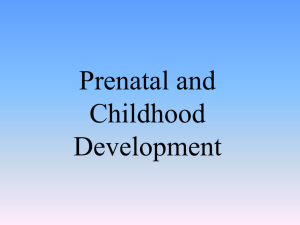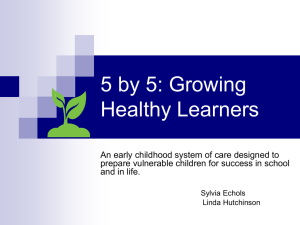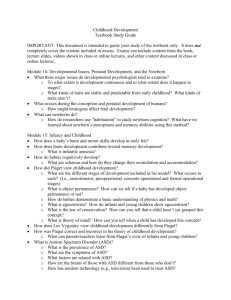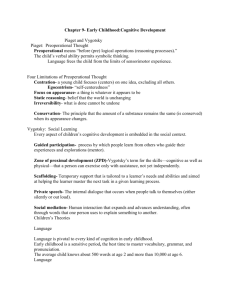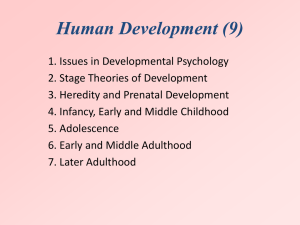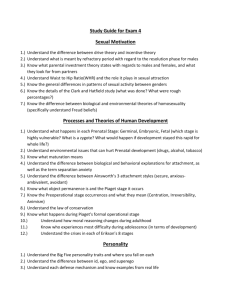Prenatal and Childhood 1 Post
advertisement
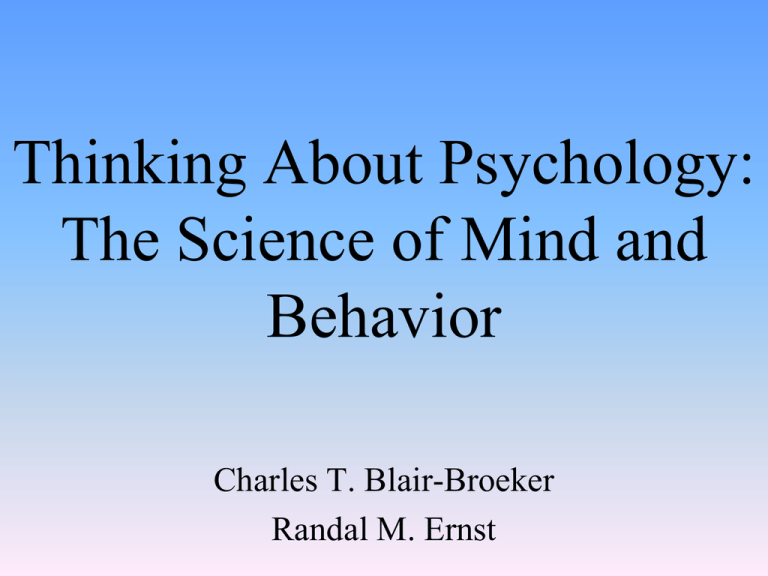
Thinking About Psychology: The Science of Mind and Behavior Charles T. Blair-Broeker Randal M. Ernst Module 04 Prenatal and Childhood Development Module 4: Prenatal and Childhood Development The Beginnings of Life: Prenatal Development Prenatal Development • Prenatal defined as “before birth” • Prenatal stage begins at conception and ends with the birth of the child. Zygote • A newly fertilized egg • The first two weeks are a period of rapid cell division. • Attaches to the mother’s uterine wall • At the end of 14 days becomes an embryo Prenatal Development Embryo • Developing human from about 14 days until the end of the eight week • Most of the major organs are formed during this time. • At the end of the eight week the fetal period begins. Fetal Period • The period between the beginning of the ninth week until birth Placenta • A cushion of cells in the mother by which the fetus receives oxygen and nutrition • Acts as a filter to screen out substances that could harm the fetus Teratogens • Substances that pass through the placenta’s screen and prevent the fetus from developing normally • Includes: radiation, toxic chemicals, viruses, drugs, alcohol, nicotine, etc. Smoking and Birth Weight Fetal Alcohol Syndrome (FAS) • A series of physical and cognitive abnormalities in children due to their mother drinking large amounts of alcohol during pregnancy Module 4: Prenatal and Childhood Development The Beginnings of Life: The Newborn Rooting Reflex • Infants’ tendency, when touched on the cheek, to move their face in the direction of the touch and open their mouth • Is an automatic, unlearned response • Child is looking for nourishment. Temperament • A person’s characteristic emotional reactivity and intensity • A child might be: – An “easy” or “difficult” baby • Temperament shown in infancy appears to carry through a person’s life. Module 4: Prenatal and Childhood Development Physical Development in Infancy and Childhood Infant, Toddler, Child • Infant: First year • Toddler: From about 1 year to 3 years of age • Child: Span between toddler and teen Module 4: Prenatal and Childhood Development Physical Development in Infancy and Childhood: The Developing Brain Neural Development Maturation • Biological growth processes that enable orderly changes in behavior Module 4: Prenatal and Childhood Development Physical Development in Infancy and Childhood: Motor Development Motor Development • Includes all physical skills and muscular coordination Motor Development Module 4: Prenatal and Childhood Development Cognitive Development in Infancy and Childhood: Piaget’s Cognitive Stages Cognition • All the mental activities associated with thinking, knowing, and remembering • Children think differently than adults do Jean Piaget (pee-ah-ZHAY) • Developmental psychologist who introduced a stage theory of cognitive development • Proposed a theory consisting of four stages of cognitive development Schemas • Concepts or mental frameworks that people use to organize and interpret information • Sometimes called schemes • A person’s “picture of the world” Assimilation • Interpreting a new experience within the context of one’s existing schemas • The new experience is similar to other previous experiences Accommodation • Interpreting a new experience by adapting or changing one’s existing schemas • The new experience is so novel the person’s schemata must be changed to accommodate it Assimilation/Accommodation Assimilation/Accommodation Assimilation/Accommodation Sensorimotor Stage • Piaget’s first stage of cognitive development • From birth to about age two • Child gathers information about the world through senses and motor functions • Child learns object permanence Object Permanence • The awareness that things continue to exist even when they cannot be sensed • “Out of sight, out of mind” Preoperational Stage • Piaget’s second stage of cognitive development • From about age 2 to age 6 or 7 • Children can understand language but not logic Egocentrism • The child’s inability to take another person’s point of view • Includes a child’s inability to understand that symbols can represent other objects Concrete Operational Stage • Piaget’s third stage of cognitive development • From about age 7 to 11 • Child learns to think logically and understands conservation Conservation • An understanding that certain properties remain constant despite changes in their form • The properties can include mass, volume, and numbers. Conservation Conservation Conservation Types of Conservation Tasks Formal Operational Stage • Piaget’s fourth and last stage of cognitive development • Child can think logically and in the abstract • About age 12 on up • Can solve hypothetical problems (What if…. problems) Module 4: Prenatal and Childhood Development Cognitive Development in Infancy and Childhood: Assessing Piaget Assessing Piaget’s Theory • Piaget underestimated the child’s ability at various ages. • Piaget’s theory doesn’t take into account culture and social differences. Piaget Role Review • Name in order Piaget’s 4 stages of cognitive development. For each stage state at what age he believed they occurred. • What was the biggest criticism of Piaget’s theories? Module 4: Prenatal and Childhood Development Social Development in Infancy and Childhood Stranger Anxiety • The fear of strangers an infant displays around 8 months of age Module 4: Prenatal and Childhood Development Social Development in Infancy and Childhood: Attachment Attachment • An emotional tie with another person resulting in seeking closeness • Children develop strong attachments to their parents and caregivers. • Body contact, familiarity, and responsiveness all contribute to attachment. Harry Harlow • Did research with infant monkeys on how body contact relates to attachment • The monkeys had to chose between a cloth mother or a wire mother that provided food. Harry Harlow • The monkeys spent most of their time by the cloth mother. Harry Harlow Harlow’s Studies • Insert “Harlow’s studies on Dependency in Monkeys” Video #12b from Worth’s Digital Media Archive for Psychology • Instructions for importing the video file can be found in the ‘Readme’ file on the CD-ROM Harlow’s Study Segment 23-Bringing Up Monkey • Watch the video clip and answer the following questions • 1.What two personality styles have been identified in rhesus monkeys. How do these styles relate to a monkey’s relationship with his or her mother. • 2. How did Steve Sumi and his team of researchers investigate the origins of these personality styles? What were the major findings? Segment 23 Cont. • 3. What do you conclude from these studies regarding the stability of personality and the impact of parental styles on the behavior of children. • 4. Are animals studies useful in broadening the knowledge base of psychology and contributing to our understanding of human development. Familiarity • Sense of contentment with that which is already known • Infants are familiar with their parents and caregivers. Imprinting and Critical Period • A process by which certain animals, early in life, form attachments • The imprinted behavior develops within a critical period--an optimal period when the organism’s exposure to certain stimuli produce the imprinted behavior. • Konrad Lorenz studied imprinting. Konrad Lorenz • Studied imprinted behaviors • Goslings are imprinted to follow the first large moving object they see. Konrad Lorenz Video Clip Module 4: Prenatal and Childhood Development Social Development in Infancy and Childhood: Parenting Patterns Responsiveness • Responsive parents are aware of what their children are doing. • Unresponsive parents ignore their children--helping only when they want to. Securely or Insecurely Attached • Securely attached – children will explore their environment when primary caregiver is present • Insecurely attached – children will appear distressed and cry when caregiver leaves. Will cling to them when they return Attachment Effects of Attachment • Secure attachment predicts social competence. • Deprivation of attachment is linked to negative outcome. • A responsive environment helps most infants recover from attachment disruption. Parental Patterns • Daumrind’s three main parenting styles – Authoritarian parenting – Permissive parenting – Authoritative parenting Authoritarian Parenting • Low in warmth • Discipline is strict and sometimes physical. • Communication high from parent to child and low from child to parent • Maturity expectations are high. Permissive Parenting • High in warmth but rarely discipline • Communication is low from parent to child but high from child to parent. • Expectations of maturity are low. Authoritative Parenting • High in warmth with moderate discipline • High in communication and negotiating • Parents set and explain rules. • Maturity expectations are moderate. Parenting Styles Module 4: Prenatal and Childhood Development Three Key Developmental Issues Continuity and Stages • How much of behavior is continuous and how much follows a more stage like development? Types of Growth Patterns Stability and Change • What developmental traits remain stable over time, and which change? Nature and Nurture • How much of our behavior is due to nature and how much is due to nurture? • How do nature and nurture interact in development? The End

